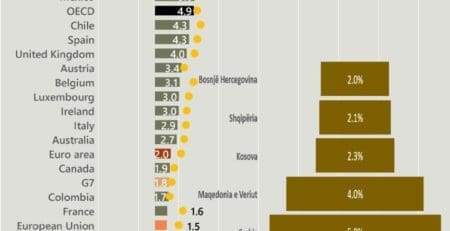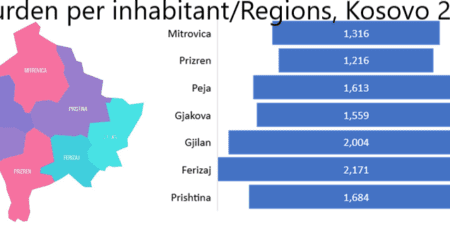The balance of payments shows us that the economy performs poorly and why tourism shows signs of growth
In the latest publication of the Bank of Albania, on September 11, we can see a clearer picture of the balance of payments made for the first 6 months of 2023. These payments summarize the transactions of the government, businesses, organizations and individuals with the partners of theirs abroad, as well as monetary transactions paid by foreign counterparts in our country[1].
In the first and second quarters of 2023, the trade deficit according to payments for import and export has increased in both consecutive quarters compared to the respective quarters in 2022.
In the comparison between them, it can be seen that the trade deficit has increased by 75 million Euros in the first quarter and by 222 million Euros in the second quarter.
The deficit was affected both by the decrease in export payments in the second quarter of 2023 by 84 million Euros, but also by the increase in imports in both quarters, respectively according to the period in 2023 by 79 million Euros and 139 million Euros.
| T I 2022 | T II 2022 | T III 2022 | T IV 2022 | T I 2023 | T II 2023 | ||
| Goods | -816 | -998 | -1,216 | -1,239 | -891 | -1,220 | |
| Credit (m.Euro) | 483 | 509 | 477 | 464 | 487 | 425 | |
| Debit (m.Euro) | 1,299 | 1,507 | 1,693 | 1,703 | 1,378 | 1,646 |
This situation of the trade balance of payments shows that exports are not growing according to the indicators above, but they are also a confirmation of public statements by representatives of an inherent part of private sector exports.
This influencing factor in Albanian exports for the part related to goods and raw materials entering Albania for processing, if we refer to the data in the table below.
| T I 2022 | T II 2022 | T III 2022 | T IV 2022 | T I 2023 | T II 2023 | |
| Goods for processing in Albania | 158 | 182 | 133 | 152 | 196 | 198 |
| Credit (m. Euro) | 501 | 596 | 491 | 572 | 574 | 588 |
| Debit (m. Euro) | 343 | 413 | 358 | 420 | 378 | 390 |
From the data of the indicator “Goods for processing in Albania”, it is observed that in the first and second quarter of 2023, incoming payments were made for the value of goods for processing, respectively 574 million Euros and 588 million Euros, and payments were made to pay the value of these goods, respectively for the same periods of 2023, 378 million Euros and 390 million Euros. Compared to the first and second quarters of 2022, there is a slight increase of 73 million euros in the first quarter of 2023 and a decrease of 8 million euros in the second quarter. Based on the data that Albanian exporters present directly from their balance sheets, it seems that this downward trend has continued in at least two months of the third quarter of 2023.
In its entirety, the data from the trade balance indicate an increasing influence of imports to decreasing exports, giving its influence also in the weakening of the Euro, at levels not massively large compared to the first 6 months of 2022.
But, in an already comparison of the data indicators of the entries of foreign citizens for the first 6 months of 2022 and 2023, the indicators from INSTAT present data as follows:
| Entry-Exit visitors values spent | 6m. I 2022 | 6m. I 2023 | Difference |
| Foreign visitors (m. Euro) | 2.55 | 3.39 | 0.84 |
| Albanian visitor exit abroad (m. Euro) | 2.52 | 3.02 | 0.5 |
In the first 6 months of 2023, 3.39 million foreign citizens entered for the purposes of medical, official, personal, tourism visits with an increase of 840 thousand more citizens compared to 2022.
While 3.02 million Albanian citizens came for the same visit purposes as above with an increase of 500 thousand more citizens.
If we compare these data on the number of visitors with the balance of payments according to the periods above, according to the table below we notice that in the first 6 months of 2023, 1.55 billion Euros, or 423 million Euros, were spent by foreign citizens (visitors). more than in the first 6 months of 2022.
Meanwhile, from the payments that Albanian citizens have made for the same purposes in other countries, 977 million Euros have left the country, or 183 million Euros more than in the first 6 months of 2022. If we make a balance of incoming payments from foreigners with outgoing payments from Albanians, it turns out that 240 million Euros remained as foreign currency[2] in the Albanian market, which is considered a monetary addition compared to last year.
| T I 2022 | T II 2022 | T III 2022 | T IV 2022 | T I 2023 | T II 2023 | |
| Tourism | 86 | 252 | 505 | 226 | 189 | 388 |
| Credit (m. Euro) | 409 | 722 | 1,061 | 648 | 624 | 930 |
| Debit (m. Euro) | 323 | 471 | 556 | 421 | 435 | 542 |
In a comparison between the same 6-month period of 2022 and 2021, where the net value between payment inflows and outflows was only 50 million Euros, it can be seen as an indicator with a greater impact than has been estimated so far. But anyway, if we see that the weakening of the Euro is clearly much lower than the effect of only 240 million additional euros in the economy, our experts reserve the right to extend the comparative analysis even further.
Another indicator that has been seen on a 6-month comparative basis for 2022 and 2023 is remittances or remittances from abroad by immigrants.
In the first 6 months of 2022, remittances from immigrants are calculated at a total value of 376 million Euros and in the first 6 months of 2023, remittances from immigrants are calculated at 444 million Euros, or 68 million Euros more in the Albanian payment market .
Such an amount of remittances is obviously addressed to the real estate market, but also to the consumption of goods and products in the domestic market.
| T I 2022 | T II 2022 | T III 2022 | T IV 2022 | T I 2023 | T II 2023 | |
| Remittances | 184 | 192 | 216 | 242 | 214 | 230 |
| Credit (m. Euro) | 184 | 192 | 216 | 242 | 214 | 230 |
| Debit (m. Euro) | 0 | 0 | 0 | 0 | 0 | 0 |
Vlera monetare prej 68 milionë Euro më shumë është një ndikues në ofertën e Euros në tregun e këmbimit, por me një peshë të vogël nëse vlerësojmë se kjo shumë është shpërndarë më shumë për 6 muaj me radhë dhe në sasi jo të barabarta.
Për të vijuar më tej me analizën, në treguesit e rëndësishëm të bilancit të pagesave janë edhe vlerat e investuara në mbi gjysmën e tyre në Euro dhe pjesa tjetër në valuta të tjera.
Vlera bruto e investimeve të huaja në 6-mujroin e parë 2022 është në vlerën e konvertuar të 640 milion Euro dhe në 6-mujorin e parë 2023 në vlerën e konvertuar të 686 milion Euro, me një rritje prej 46 milion Euro më shumë në 2023.
| T I 2022 | T II 2022 | T III 2022 | T IV 2022 | T I 2023 | T II 2023 | |
| Gross direct investment (m. Euro) | 303 | 337 | 344 | 388 | 307 | 379 |
| Direct investor in direct investment companies | 111 | 160 | 152 | 184 | 143 | 186 |
| Direct investment companies to the direct investor (reverse investment) | 0 | 0 | 0 | 0 | 0 | 0 |
| Profit reinvested | 167 | 170 | 195 | 199 | 182 | 194 |
| Debt instruments | 25 | 7 | -3 | 5 | -17 | -1 |
But, if we see according to the table below that the payments made for investments made outside of Albania have increased in 2023, then this indicator should also be viewed with due attention to understand the weight of the impacts of net investments (that remain) in the economy Albanian.
The indicators below also serve as a gauge and alarm level as to why Albanian investors are leaving the country. Thus, in 2022 the value of payments for investments abroad is 90 million Euros, while in the first 6 months of 2023 it is 126 million Euros.
If we add to this indicator in the comparative analysis of values the fact of a narrow portfolio of foreign investments in the country, then the entire segment related to capital investments needs a deep reformation to get out of this decline instead of increasing capital for investment.
| T I 2022 | T II 2022 | T III 2022 | T IV 2022 | T I 2023 | T II 2023 | |
| Outward direct investment (m. Euro) | 36 | 54 | 48 | 44 | 50 | 76 |
| Direct investor in direct investment companies | 23 | 31 | 30 | 19 | 31 | 60 |
| Direct investment companies to the direct investor (reverse investment) | 0 | 0 | 0 | 0 | 0 | 0 |
| Profit reinvested | 14 | 12 | 17 | 23 | 21 | 11 |
| Debt instruments | -2 | 11 | 1 | 3 | -2 | 4 |
In summary of all the indicators above, in a foreign exchange market where the Euro has weakened the effectiveness of exports and has probably affected a part of consumption by Albanian residents, it is necessary to accept that the situation should not be left looking at the indicators of the quarter of third, since it is the Albanians themselves who feel that the cost of living has increased and informality is eroding every day the government’s initiatives for the recovery of the economy.
[1] https://www.bankofalbania.org/rc/doc/METODIK_1421_1_9300.pdf
https://www.bankofalbania.org/?crd=0,8,1,1,0,17830&uni=20230911145607162158210189185160&ln=1&mode=alone
[2] Currencies spent by foreign visitors in US dollars, Euros, British pounds, Swiss francs, etc. They are all converted to Euro to have it as the same monetary unit as the payments of Albanians abroad




Leave a Reply
You must be logged in to post a comment.